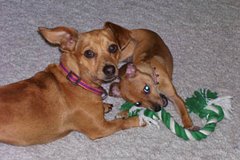- Pre-Made Raw Diets - These are raw diets that you can buy already prepared. They come in a number of varieties such as chicken, lamb, rabbit, beef, pork, etc. Some have vegetables mixed in and some don't. Some have bones ground in with the meat, and some don't. Here are a couple pre-made raw food companies:
Healthy Pet Products Beef Complete
Bravo! Raw Diets
Omas Pride
Nature's Variety
While these pre-made diets are convenient, they tend to be expensive if you're feeding a large dog or multiple dogs. Because they're ground, these diets also don't provide the dental benefit dogs receive from eating raw meaty bones.
- BARF - BARF stands for "bones and raw food." When you follow this diet, you feed your dog a combination of raw meat, meaty bones, raw fruits and vegetables, and some dairy products. Some people also feed grain, although that's not really needed.
- Prey-Model - The prey-model of raw feeding tries to mimic what a wolf would naturally eat in the wild. The more complete the animal, the better. For example, many people feeding prey-model will give a dog a rabbit with hair and everything. It is possible to feed a prey-model diet without going to this extreme however. The point is to feed your dog just meat and bones, with a great variety in the meat.
Now that you understand the basic differences in the raw diets, we'll move on to portion sizes in our next blog entry.
